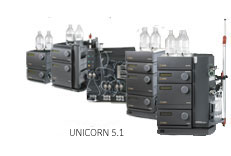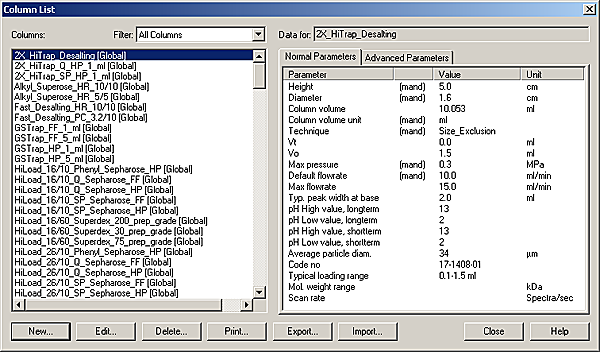

|
|
How to edit the Column List
|

|
|
Introduction

|
This section describes how to edit the list of available columns.
|
|
|
|
|
Available columns

|
When you create a new method and select a column, certain
column-specific parameters are automatically copied into the method.
The list of available columns is found in the For column field of the New Method dialog box. The Column List is not linked to a
particular method, although the columns are edited within the Method Editor.
Columns are either globally available to all users, or only
personally available. It is best not to edit the globally available
columns, unless you save the changes under a new column name, since
other users may not appreciate the changes.
Note: It is recommended
that only a limited number of users are given access to the right
to edit global columns. This is essential to avoid unintentional
changes.

|
|
|
|
|
How to print the column list

|
The table below describes how to print the column list data.
|
Step
|
Action
|
|
1
|
Result: The Print
Column List dialog box opens.
|
|
2
|
Result: The column
list is printed on the default Windows printer.
|
|
|
|
|
|
The New Column dialog box

|
The illustration below shows the New
Column dialog box:

|
|
|
|
|
How to add a new column

|
The
table below describes how to add a new column to the Column List.
|
Step
|
Action
|
|
1
|
Result: The Column List dialog box opens.
Note: Select a column
from the list to display the parameters in the field to the right.
Most column parameters are displayed in the Normal
Parameters tab. Additional parameters for special columns
may be displayed in the Advanced Parameters tab.
|
|
2
|
Result: The New Column dialog box opens.
|
|
3
|
-
Select the
appropriate parameter tab.
-
Type the desired parameter values.
-
Click the Save as button.
Note: Mandatory
parameters are labelled mand.
The column cannot be saved unless all mandatory parameters are filled
in.
Result: The Save as dialog box opens.
|
|
4
|
Note: You must have Edit global lists authorization
to save a column for global use. A global column cannot have the
same name as a personal column.
Result: The new
column is added to the Column List.
|
Note: See column
instruction to determine the back pressure over the system and the
column.
|
|
|
|
|
The normal column parameters

|
The
table below is a list of all the available normal column parameters:
|
Parameter
|
Unit
|
Comment
|
|
Height
|
cm
|
-
Mandatory.
-
Calculation of N/m.
|
|
Diameter
|
cm
|
|
|
Column volume
|
nl, µl, ml or liter
|
|
|
Column volume unit
|
nl, µl, ml or liter
|
|
|
Technique
|
|
|
|
Vt
|
nl, µl, ml or liter
|
|
|
Vo
|
nl, µl, ml or liter
|
|
|
Max pressure
|
MPa
|
|
|
Default flowrate
|
nl/min, µl/min, ml/min or liter/min
|
|
|
Max flowrate
|
nl/min, µl/min, ml/min or liter/min
|
|
|
Typ. peak width at base
|
nl, µl, ml or liter
|
|
|
pH high value, longterm
|
|
|
|
pH low value, longterm
|
|
|
|
pH high value, shortterm
|
|
|
|
pH low value, shortterm
|
|
|
|
Average particle diameter
|
µm
|
-
Not mandatory.
-
Information only.
|
|
Code no
|
|
-
Not mandatory.
-
Information only.
|
|
Typical loading range
|
mg
|
-
Not mandatory.
-
Information only.
|
|
Mol. weight range
|
kDa
|
-
Not mandatory
-
Information only
|
|
Scan rate
|
spectra/sec
|
-
Not mandatory.
-
Information only.
|
Note: The values for the parameters Max
pressure, Default flowrate and Typical peak width at base (used
to set average time and peak fractionation parameter MinWidth) are only copied into
the method if the corresponding instructions are available as variables.
|
|
|
|
|
How to edit column parameters

|
The
table below describes how to edit column parameters in the Method Editor:
|
Step
|
Action
|
|
1
|
Choose Edit:Column List.
Result: The Column List dialog box opens.
|
|
2
|
Select a column and click the Edit button.
Result: The Edit Column dialog box opens.
|
|
3
|
Select the desired parameters and change the value
settings.
|
|
4
|
or
|
Note: If a column
has been selected and saved in a method, and the parameters for
the column are changed later, the column in the method will not
be updated automatically. When you open the method you will be asked
if you want to update the parameters. The recommendation is that
you answer Yes.
|
|
|
|
|
How to delete a column

|
The
table below describes how to delete a column:
|
Step
|
Action
|
|
1
|
Choose Edit:Column List.
Result: The Column List dialog box opens.
|
|
2
|
Select a column and click the Delete button.
Result: The Delete Column dialog box opens.
|
|
3
|
Result: The selected
columns are deleted.
|
|
|
|
|
|
How to export a column

|
The
column information for a system can be transferred to another by
using the export and import functions in the column list. The table
below describes how to export a column:
|
Step
|
Action
|
|
1
|
Choose Edit:Column List.
Result: The Column List dialog box opens.
|
|
2
|
Click the Export button.
Result: The Export Column dialog box opens.
|
|
3
|
Result: The Export Column to file dialog box
opens.
|
|
4
|
-
Select the
desired folder in the navigation window.
-
Type a new file name if neccessary.
-
Choose the type of file to export (column file or
Excel file)
-
Click the Save button.
Result: The column
file is saved and the dialog box closes.
|
Note: If a column
is selected in the Column List when
the Export Column dialog
box is opened, this column will automatically be selected in the Export Column dialog box.
|
|
|
|
|
How to import a column

|
The
table below describes how to import a column:
|
Step
|
Action
|
|
1
|
Choose Edit:Column List.
Result: The Column List dialog box opens.
|
|
2
|
Click the Import button.
Result: The Import Column dialog box opens.
|
|
3
|
Result: The Import Column from file dialog
box opens.
|
|
4
|
-
Select a column
file.
-
Click Open.
Result: The Import
Columns dialog box opens.
|
|
5
|
Result: The selected
columns are imported and available in the column list.
|
Note: Select Import
as global to import the columns to the global column
list.
|
|
|
|
2005-06-15
|
|
|